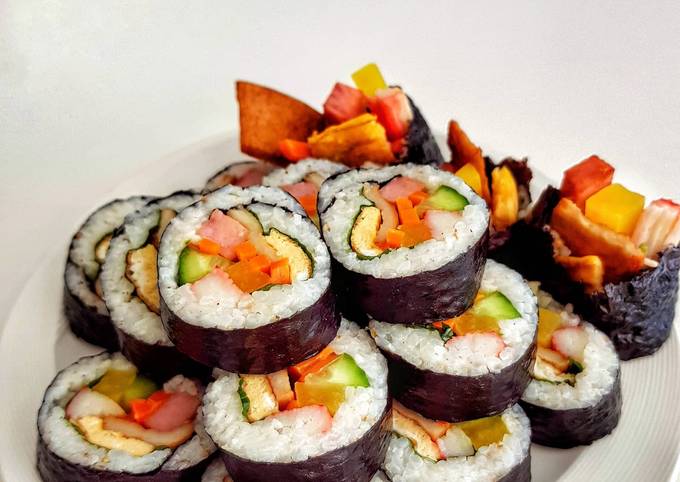Kimbap (Korean seaweed rice rolls). Gimbap (also sometimes spelled "kimbap") is the perfect meal on-the-go, a common sight at bus stations and a must-have at school picnics. The only limit for kimbap fillings is your imagination: You can find tuna, avocado, chicken, shrimp, and bulgogi kimbap. Basically, you can feel free to add whatever you want to the roll.
 Kimbap - Korean dried seaweed rice rolls So what does Kimbap - Seaweed Rice Roll remind me of?
Kimbap is seaweed and rice rolled around vegetables and some type of protein.
It is child-friendly food that adults enjoy, too.
You can cook Kimbap (Korean seaweed rice rolls) using 13 ingredients and 8 steps. Here is how you achieve that.
Kimbap - Korean dried seaweed rice rolls So what does Kimbap - Seaweed Rice Roll remind me of?
Kimbap is seaweed and rice rolled around vegetables and some type of protein.
It is child-friendly food that adults enjoy, too.
You can cook Kimbap (Korean seaweed rice rolls) using 13 ingredients and 8 steps. Here is how you achieve that.
Ingredients of Kimbap (Korean seaweed rice rolls)
- Prepare of cooked rice.
- Prepare of sesame oil.
- Prepare of toasted sesame seeds.
- Prepare of salt.
- You need of cucumber.
- Prepare of carrot.
- Prepare of long slices of pickled radish.
- Prepare of long slices of luncheon meat/ham.
- It's of perilla leaves (optional).
- Prepare of large eggs.
- You need of fish cake.
- It's of dried seaweed sheets.
- Prepare of olive oil.
Because the rolls are sturdy and eaten out of hand, they are great. Kimbap— also known as gimbap —are Korean rice rolls that might look a lot like sushi but, in truth, are nothing like it. Kimbap is seaweed and rice rolled around vegetables and some type of protein. It is child-friendly food that adults enjoy, too.
Kimbap (Korean seaweed rice rolls) step by step
- Cut the carrot into small pieces. Oil the pan with 1 tbsp olive oil on medium heat, and lightly sauté the carrots..
- Oil the pan with another tbsp of olive oil. Beat the eggs and make a flat omelette on the pan..
- Oil the pan with another tbsp of olive oil. Cut the fish cake into thin, one-inch strips and lightly sauté them..
- Slice the cucumber, pickled radish, eggs, and luncheon meat/ham into thin strips as shown below. Cut the perilla leaves in half, if using..
- Add sesame oil, sesame seeds, and salt to the cooked rice and mix thoroughly..
- Wrap a bamboo mat or a sheet of aluminum foil with a plastic wrap, and place a sheet of seaweed laver on top of the mat. Spread about 1/2 cup of rice evenly on the sheet, and lay all the ingredients at the bottom half of the sheet..
- As if rolling a sleeping bag, carefully roll it up starting from the bottom, tucking the ingredients into the roll as you go. When a roll has been formed, squeeze gently for it to hold shape..
- Slice it into bite-sized rolls. Enjoy!.
Because the rolls are sturdy and eaten out of hand, they are great. Kimbap is a two word combination of Kim and Bap. Kim means dried sheets of laver seaweed and Bap means cooked rice. The cooked rice is spread out over a sheet of dried seaweed whilst vegetables and other ingredients are laid on top and rolled up into what must be one of the healthiest convenience foods out there. Some might think of gimbap or kimbap (pronounced "keem-bahp") simply as Korean sushi, but it really stands on its own.